#george and henry are there for 30 seconds
Text
Comfortember Day 9 - Aftermath
William immediately headed to the room that had been prepared before any of them came in. Terrence Meyers and his father made sure that a safe house was prepped and cleaned before transferring his people, James Pendrick, and Llewellyn from the small hospital.
Julia, thankfully, hadn’t lost her license straight out. The tape with her confession on having to operate on Llewellyn as the only doctor able to at the moment had been sent to the board. They were debating on possible punishments, or even if she deserved them. Now, she had taken up residence in the room shared by the worst of the injured. James, who remembered underneath rubble, had slowly been regaining his modern memories as he dealt with the past ones. His shoulder was once again, dislocated. At least with modern rehab techniques, it wouldn’t end up like it had in the previous life.
There was a doctor and nurse pair sent from the intelligence agency, vetted by Meyers and Harry before being allowed to step in and work on the four. Henry was propped up with a computer and offsite access to the intelligence information, barely waiting until the concussion was gone before diving into the investigation as best as he could. George was recuperating from the broken arm and an infection that he managed to get from the exposed bone marrow. The two were bickering and talking while they waited for the worst to pass through George and he could be up adding to research again.
Llewellyn had only woken up twice since his massive surgery, which worried the maternal part of Julia but not her medical background. Impaled through the lung, massive loss of blood, right arm had multiple breaks and his left has restricted blood flow for hours, one leg broken and the other with a jagged, deep laceration. It wasn’t a surprise that he wasn’t more awake, although that meant he was on an IV drip and had nothing to eat for a few days. He wouldn’t be moving for at least half a year, and she believed he wouldn’t be halfway to his old physical self for over a year.
Once he could stay awake, he would go insane.
Julia had taken over a couch. After the first two days of resting and eating from her intense work, she was just watching over her son while talking with James. She didn’t want to leave him until he was able to keep a cohesive thought and stay awake for more than an hour.
Murdoch had been going out with Meyers and Harry, working the bombing just the same as any case back in Toronto. Evidence was being processed steadily, although it was hard getting to the shrapnel and possible fragments left. The people working there were slowly being interviewed for what they saw, knew about Pendrick, and everything surrounding him. It was long, taking the better part of two hours.
There was also a fair bit to go through. Thankfully, there was already a table when he made his way to the room. He laid down the files and lightly kissed Julia before sitting down himself. “There’s going to be dinner delivered in an hour. Harry’s bringing pizza.”
Julia nodded, settling herself down on his side. “A good change from the canned soups Meyers brought and dropped off. The kitchen isn’t the greatest for cooking anything.”
He knew that well enough. The microwave died out when he started using that, and the stove was barely functional. There was a lighter sitting next to it to ignite gas when they turned the knobs. “Hopefully, it’ll be filling. Doing investigations into a terrorist act with Meyers hanging over my head is a lot more exhausting than it was previously.”
She huffed. “I know they’ve had issues with getting money, but a microwave can’t cost that much.”
“What is it, like, a hundred dollars?” a tired voice mocked. James was awake, and starting to listen in on the couple.
Murdoch nodded, somewhat understanding the reference. “One of the first ones I ever took apart was about that much. Mary screamed when she saw I had taken apart the one they were planning on sending to the trash. She and Caleb had to warn me about the dangers of unplugged microwaves.” Julia smacked him. Of course, he would do something dangerous like that.
“It was the first family one. Dad was so angry at me tearing that apart,” James admitted.
“At least you never,” a tired voice started. Julia snapped her head around when she saw Llewellyn looking over, “Had to deal with that from me.”
“Llewellyn,” she said, standing up and going over to the bed.
His smile was weak. “Just fingerpainted on Grandpa’s canvases.” William joined Julia by her side, gently pressing the back of his hand to an uncovered part of his arm. He hadn’t seen him awake at all since finding him in the rubble.
She threaded through his hair. “Those were pretty pennies to replace. Although he told me that one of those paintings sold well enough that he almost wanted to let you keep doing it.” He smiled, then grimaced at something sending a sharp pain through him. “Where?”
“S-side,” he whispered, closing his eyes when another sharp pain went through.
“Do you want a hit?”
He shook his head. “No. Don’t like fuzzy.” Julia frowned, as she didn’t like watching him be in pain. “I’ll ignore it,” he breathed, “Like I do the ‘artbreak.”
“You didn’t ignore that, you stole two bottles of wine while she was out doing interviews,” William ratted out.
“Hey,” he protested. There was a promise weaseled out of him to never tell Julia about what he did after being dumped by Jack.
“Llewellyn,” she hissed. Honestly, she already had a thought that something had happened the two weeks she had to go cross country promoting her new work. Coming home and feeling a change in the status quo between William, Dad, and Llewellyn, she carefully watched them for two weeks. Never quite picked it up, but now knowing there were two bottles that he must have drunk after Jack made her wonder about the time.
“I, replaced them!”
“You, out of all people, should know about underage drinking and how dangerous, and bad, it can be for you,” she said.
“Wasn’t that bad last time,” he murmured, falling asleep.
That frown was more pronounced than the last one. “I think,” James said, “That I will take a walk-”
“Stay down,” she ordered, pointing at him with not even stopping her other hand. “William, we will be having a Talk about what happened.”
William knew how that was going to go. Which, he was grateful for Henry and George managing to get in the door. George had the laptop while Henry leaned on the crutches. “Should we come back later?” he asked, knowing he would get two different answers, at least.
“Yes.” Julia.
“No.” Murdoch.
“Please don’t leave me with them.” James. The last had everyone except the sleeper looking at him. “Mom and Dad are fighting,” he mocked, pointing at the two. George set down the laptop while getting more chairs. William went with him. “Anything on who bombed my lab and almost killed me?”
“A couple of suspects,” Henry said, taking Julia’s chair with permission. She nabbed William’s to look at the computer.
“Good. As long as one of them isn’t Allen Clegg,” he shuddered, remembering the rabies mutation that he made last time.
“Haven’t ran across him yet,” Henry relayed, “Or Sally. She is in the country, however.”
“Ugh,” he moaned, “At least she didn’t frame me this time.”
“William would have seen through it in a minute,” Julia said. “All of them would have.” Two more chairs, and the small group settled to start going through evidence that Henry dug up.
#comfortember2023#comfortember 2023#murdoch mysteries#castle reincarnation au#julia ogden#william murdoch#james pendrick#llewellyn watts#george and henry are there for 30 seconds
3 notes
·
View notes
Text
for the new year, i have decided to make a couple edits and additions to the almighty Calendar. happy 2024.
IT JUST HAPPENS
DAY 15 GIVE IT UP FOR DAY 15
Thursday the 20th
The Fifth of Wednesday
Second Week of May: Eurovision
Sometime in June: That One Halloween Post Starts Circulating
Sometime in July: Dancing Pumpkin Man Video/Gif
WEEKLY EVENTS
(at least the ones i celebrate)
Every Monday: Garfield Hates Mondays
Every Tuesday: Tom Servo Tuesday
Every Wednesday: It Is Wednesday My Dudes
Every Thursday: Out of Touch Thursday
Every Friday: Flat Fuck Friday
Every Saturday: Sea Slug Saturday
Every Sunday: Energy Sword Sunday
YEARLY EVENTS
January 1: Copyright Expiration Day
January 8: Spiders Georg Day
January 16: Appreciate a Dragon Day
January 18: Bug Race
January 29: Threshold Day
All of February: Funguary
ALSO All of February: Femslash February
February 3: WOE, VANILLA EXTRACT BE UPON YE
February 13: Galentines Day
February 14: Aromantic/Asexual Day
March 9: Miku Day
March 10: Mario Day
March 14: Pi Day
March 15: Ides of March
March 23: Ever Given Got Stuck Today
April 1: Mishapocalypse
April 2: Dashcon Announcement Anniversary
April 3: Dannypocalypse
April 8: Rex Manning Day
ALSO April 8: MARGARET THATCHER IS DEAD
April 13: Neil Banging Out The Tunes
ALSO April 13: Homestuck Day
April 20: haha 420 blaze it
April 25: The Perfect Date
April 28: Ed Balls Day
April 30: It's Gonna Be May
All of May: Mermay
May 3: Beginning of Dracula Daily
May 4: May the 4th Be With You
May 5: Revenge of the Fifth
May 25: The Glorious 25th of May
All of June: Pride Month
ALSO All of June: IT'S HALLOWEEN TIME TO GET SPOOKY
June 5: Barricade Day
ALSO June 5: RONALD REAGAN IS DEAD
June 12: Another Homestuck Day
June 16: Let Papyrus Say Fuck
June 22: Summerween
All of July: Disability Pride Month
July 11-13: Dashcon Anniversary
July 20: Moon Landing
September 8: The Queen Is Dead and Sans Undertale Killed Her
September 11: Mole Interest Monday
September 19: Talk Like A Pirate Day
September 21: DO YOU REMEMBER-
All of October: SKELETON WAR
ALSO All of October: People Draw A Lot Month? (so many names)
October 3: Mean Girls Day
ALSO October 3: Fullmetal Alchemist Day
October 13: Treat Yo' Self
October 20: Unnecessary Feelings Day
October 31: HALLOWEEN
November 5: honestly what didn't happen that day
November 19: Goncharov
November 29: HENRY KISSINGER IS DEAD
All of December: Will the Gävle Goat Get Destroyed Again?
December 10: Please, It's Christmas
December 12: Hawaii Part 2
December 23: Christmas Adam
December 24: ALMOST CHRISTMAS MEANS IT WASN'T CHRISTMAS
ALSO December 24: Cabinet Man Day
December 27: Porn Ban Effective Today
#there's definitely more but i'm not versed enough in this#tumblr holidays#add more in the tags/comments please#look i'm trying my best here i've been on tumblr for just over a year at this point#tumblr#tumblr calendar#it's complete. now i may rest.#holidays
32K notes
·
View notes
Text

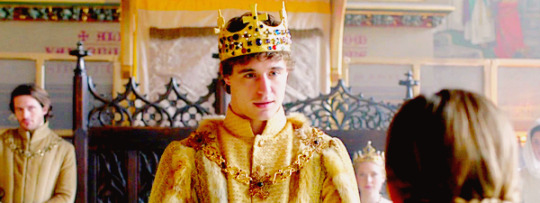
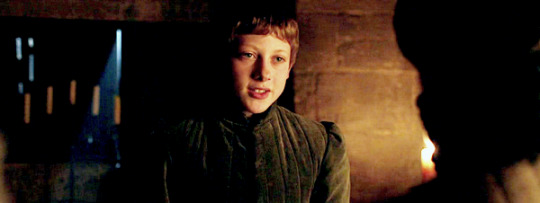

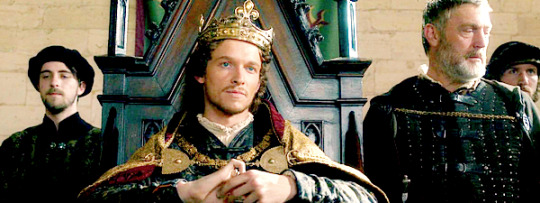
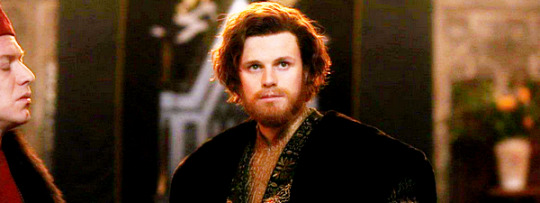
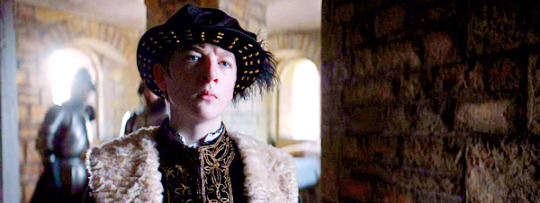
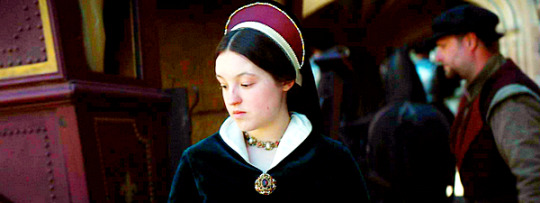




KINGS & QUEENS REGNANT OF ENGLAND ACCORDING TO STARZ
Henry VI (1 September 1422 - 4 March 1461, 3 October 1470 - 11 April 1471 second reign) as portrayed by David Shelley in The White Queen
Edward IV (4 March 1461 - 3 October 1470, 11 April 1471 - 9 April 1483 second reign) as portrayed by Max Irons in The White Queen
Edward V (9 April 1483 - 25 June 1483) as portrayed by Sonny Ashbourne Serkis in The White Queen
Richard III (26 June 1483 - 22 August 1485) as portrayed by Aneurin Barnard in The White Queen
Henry VII ( 22 August 1485 - 21 April 1509) as portrayed by Jacob Collins-Levy in The White Princess
Henry VIII (22 April 1509 - 28 January 1547) as portrayed by Ruairi O'Connor in The Spanish Princess
Edward VI (28 January 1547 - 6 July 1553) as portrayed by Oliver Zetterstrom in Becoming Elizabeth
Jane Grey (10 July 1553 - 19 July 1553) as portrayed by Bella Ramsey in Becoming Elizabeth
Mary I (19 July 1553 - 17 November 1558) as portrayed by Romola Garai in Becoming Elizabeth
Elizabeth I (17 November 1558 - 24 March 1603) as portrayed by Alicia Von Rittberg in Becoming Elizabeth
James I and VI of Scotland (24 March 1603 - 27 March 1625) as portrayed by Tony Curran in Mary & George
Charles I (27 March 1625 - 30 January 1649) as portrayed by Samuel Blenkin in Mary & George
#perioddramaedit#the white queen#the white princess#the spanish princess#becoming elizabeth#mary and george#my edits#twqedit#twpedit#thespanishprincessedit#becomingelizabethedit#maryandgeorgeedit#david shelley#max irons#sonny ashbourne serkis#aneurin barnard#jacob collins levy#ruairi o'connor#oliver zetterstrom#bella ramsey#romola garai#alicia von rittberg#tony curran#samuel blenkin#henry vi#edward iv#edward v#richard iii#henry vii#henry viii
269 notes
·
View notes
Photo

Charles I of England
Charles I of England (r. 1625-1649) was a Stuart king who, like his father James I of England (r. 1603-1625), viewed himself as a monarch with absolute power and a divine right to rule. His lack of compromise with Parliament led to the English Civil Wars (1642-51), his execution, and the abolition of the monarchy in 1649.
King Charles grew tired of wrangles with Parliament over money and so decided to do without that institution for eleven years. Then between 1640 and 1642, Charles was obliged to call Parliament to raise cash for his campaigns against a Scottish army, which had occupied northern England, and a full-blown rebellion in Ireland, both fuelled by religious differences and the king’s high-handed policies. Parliament attempted to guarantee its own future, and when the king broke his promises of reform, war broke out. The English Civil War was largely fought between ‘Roundheads’ (Parliamentarians) and ‘Cavaliers’ (Royalists) in over 600 battles and sieges in England alone. Ultimately, the professional New Model Army won the day for Parliament and Charles I was tried and found guilty of treason to his own people and government. The king was executed on 30 January 1649. Oliver Cromwell (1599-1658) ruled the ‘commonwealth’ republic as Lord Protector, but his death was soon followed by the restoration of the monarchy in 1660. The new king was Charles’ son, Charles II of England (r. 1660–1685).
Family & Early Life
Charles was born on 19 November 1600 in Dunfermline Palace, Scotland. His father was James I of England (who was also James VI of Scotland, r. 1567-1625), and his mother was Anne of Denmark (l. 1574-1619), the daughter of Frederick II of Denmark and Norway (r. 1559-1588). Charles’ grandmother was Mary, Queen of Scots (r. 1542-1567). James I was of the royal Stuart line, and he had unified the thrones of Scotland and England after Elizabeth I of England (r. 1558-1603) left no heir. Charles was the second son of King James, but his elder brother Henry died of typhoid fever in 1612 and so he became the heir apparent. Charles’ elder sister Elizabeth (b. 1596) married the King of Bohemia, and her grandson would rule England as George I of England (r. 1714-1727), the first of the Hanoverian Dynasty.
Charles did not enjoy robust health as a child, he was shy - perhaps because of his stammer, and he always came second-best when compared to his more favoured brother Henry. Reaching maturity, Charles spent a lot of time with King James’ hated courtier George Villiers, the Duke of Buckingham. The duke was seen as a talentless social upstart who had enjoyed a meteoric rise only thanks to the king’s infatuation with him.
In 1624 it was arranged for Charles to marry Henrietta Maria (1609-1669), the young sister of Louis XIII of France (1610-1643). The French royal obviously did not mind the small stature of her betrothed - a mere 1.6 metres tall (5ft 4 in) or his reputation for being rather stubborn, dull-witted, and a complete stranger to a sense of humour. The couple went on to have nine children, the two eldest sons being Charles (b. 1630) and James (b. 1633), both of whom would one day become king.
Continue reading...
33 notes
·
View notes
Text
The Shadohunter Chronicles Character Showdown
First Round, Second Round, Third Round, Fourth Round, Fifth Round, Semi-Finals, Finals
Rosemary Herondale vs Arthur Blackthorn, (Feb 23)
Celine Montclaire vs Diego Rocio-Rosales, (Feb 24)
Maureen Brown vs Anna Lightwood, (Feb 25)
Christopher Lightwood vs Ragnor Fell, (Feb 26)
Julian Blackthorn vs Livvy Blackthorn, (Feb 27)
Bridget Daly vs Jon Cartwright, (Feb 28)
Nate Grey vs Sona Carstairs, (Feb 29)
Gabriel Lightwood vs Madeleine Bellefleur, (Mar 1)
Paige Ashdown vs Rupert Blackthorn, (Mar 2)
Valentine Morgenstern vs Kraig, (Mar 3)
Andrew Blackthorn vs Irene, (Mar 4)
Axel Mortmain vs Thais Pedroso, (Mar 5)
Kit Herondale vs Ke Yi Tian, (Mar 6)
The Dark Sisters vs Filomina di Angelo, (Mar 7)
Lucie Herondale vs Simon Lovelace-Lewis, (Mar 8)
Shiyun Jung vs Cameron Ashdown, (Mar 9)
Elias Carstairs vs Tavvy Blackthorn, (Mar 10)
Luke Greymark vs Will Herondale, (Mar 11)
Ash Morgenstern vs Matthew Fairchild, (Mar 12)
Sophie Collins vs Jaime Rocio-Rosales, (Mar 13)
Catarina Loss vs Tessa Grey, (Mar 14)
Jessamine Lovelace vs Woolsey Scott, (Mar 15)
Diana Wrayburn vs Magnus Lightwood-Bane, (Mar 16)
James Herondale vs Jesse Blackthorn, (Mar 17)
Sebastian Morgesnstern vs Ty Blackthorn, (Mar 18)
Julie Beavul vs Tatiana Lightwood, (Mar 19)
Meliorn vs Helen Blackthorn, (Mar 20)
Alexander Lightwood vs Arawn, (Mar 21)
Jace Lightwood-Herondale vs Michael Wayland, (Mar 22)
Raphael Santiago vs Kieran Kingson, (Mar 23)
Marisol Garza vs Hypatia Vex, (Mar 24)
Dru Blackthorn vs Ari Bridgstock, (Mar 25)
Eugenia Lightwood vs Bat Velasquez, (Mar 26)
Eliza Rosewain vs Rafael Lightwood-Bane, (Mar 27)
Anush Joshi vs Seelie Queen, (Mar 28)
Church vs Cecily Herondale, (Mar 29)
Annabel Blackthorn vs Robert Lightwood, (Mar 30)
Beatriz Mendoza vs Malcolm Fade, (Mar 31)
Jocelyn Fairchild vs Max Lightwood-Bane, (Apr 1)
Imogen Whitlaw vs Jem Carstairs, (Apr 2)
Mother Hawthorn vs Chairman Meow, (Apr 3)
Manuel Casales-Villalobos vs Barbra Lightwood, (Apr 4)
Cordelia Carstairs vs Benedict Lightwood, (Apr 5)
Divya Joshi vs Lily Chen, (Apr 6)
Patrick Penhallow vs Alastair Carstairs, (Apr 7)
Isabelle Lightwood vs Mark Blackthorn, (Apr 8)
Amatis Greymark vs George Lovelace, (Apr 9)
Maryse Lightwood vs Elliott, (Apr 10)
Alexei de Quincey vs Elyas the Demon, (Apr 11)
Hodge Starkweather vs Henry Branwell, (Apr 12)
Camille Belcourt vs Auraline, (Apr 13)
Aline Penhallow vs Roland Loss, (Apr 14)
Johny Rook vs Stephen Herondale, (Apr 15)
Rayan Maduabuchi vs Alec Lightwood-Bane, (Apr 16)
Esme Hardcastle vs Jordan Kyle, (Apr 17)
Grace Blackthorn vs Evelyn Highsmith, (Apr 18)
Jia Penhallow vs Charles Fairchild, (Apr 19)
Horace Dearborn vs Max Lightwood, (Apr 20)
Emma Carstairs vs Mina Carstairs, (Apr 21)
Charlotte Fairchild vs Aloysius Starkweather, (Apr 22)
Janus Herondale vs Zachary Carstairs, (Apr 23)
Gwyn ap Nudd vs Clary Fairchild, (Apr 24)
Maia Roberts vs Gideon Lightwood, (Apr 25)
Thomas Lightwood vs Cristina Mendoza-Rosales, (Apr 26)
#shadowhunters#the shadowhunter chronicles#tsc#the dark artifices#tda#the mortal instruments#tmi#the last hours#tlh#the wicked powers#twp#tid#the infernal devices#Shadowhunter Character Showdown 2024#Its back with more charcters then ever#*cries in a corner despiet knowing I brought this on myself*#I'll update with links as it goes along liek always
31 notes
·
View notes
Text

Mary Ann “Polly” Nichols: 26th August 1845 - 31st August 1888
Mary Ann “Polly” Nichols was born Mary Ann Walker in Soho on the 26th of August 1845. She was the second of three children born to Edward Walker and his wife Caroline. Few details remain of her childhood years but what is known is that by 1851, she had been christened.
At the age of 18, Mary married William Nichols, a machinist, on the 16th of January 1864 at Saint Bride's Parish Church. After their marriage the couple resided at 30-31 Bouverie Street before moving to live with Mary's father at 131 Trafalgar Street. The couple went on to have five children together: Edward John, born 1866, Percy George, born 1868, Alice Esther, born 1870, Eliza Sarah, born 1877, and Henry Alfred, born 1879.
On the 6th of September 1880, the family moved into their own home, 6 D-Block, Peabody Buildings, paying a rent of 5s. 9d. They lived there for only a short time before they separated under disputed circumstances. Nichol's father claimed that that William had left his daughter after having an affair with the nurse who helped in the delivery of their final child. William maintained that no such affair occurred, and the split was due to troubles caused by Mary's drinking. He and four of the children moved into an address near Old Kent Road. He sent her an allowance of five shillings a week until 1882 when he was informed that she was working as a prostitute. When authorities attempted to collect the money on her behalf, William informed them that she was earning her own money through prostitution, that she had deserted him and her children, and that she was living with another man. Law stated that if a woman was making money from 'illicit means,' Mary no longer received maintenance from her estranged husband.
Many of Mary's movements during the intervening years are unknown. We know she resided at Lambeth Workhouse in 1881 and left on 31st May that same year, and that she returned on 24th April 1882. It is also known that she lived for some months with her father until an argument caused her to leave in 1883. After this point she was in and out of workhouses, attempting to earn a living on the streets, and frequently spent this money on alcohol. In 1887 she had begun a relationship with Thomas Dew, but this had fallen apart by October. In December 1887, she was homeless and began sleeping on the streets near Trafalgar Square though through a clearance of this area, she found herself back at Lambeth Workhouse where she stayed for only two weeks.
Her movements in 1888 are more documented. The matron of Lambeth Workhouse found employment for Mary as a domestic servant in the home of Mr. and Mrs. Cowdry in Wandsworth.
Nichols wrote a letter to her father shortly after taking this position in which she wrote the following:
"I just write to say you will be glad to know that I am settled in my new place and going on all right up to now. My people went out yesterday, and have not returned, so I am in charge. It's a grand place inside, with trees and gardens back and front. All has been newly done up. They are teetotalers, and religious, so I ought to get on. They are very nice people, and I have not too much to do. I hope you are all right and the boy has work. So goodbye for the present. From yours truly, Polly."
When Edward attempted to respond to this communique, he received word that Mary had absconded from the premises, taking with her clothing that amounted to £3 10s. By that summer, she was staying at a common lodging house at 18 Thrawl Street before relocating to 56 Flower and Dean Street on 24th August.
We come, then, to the 30th of August and the last instances Mary was seen alive. She was seen at 11pm walking along Whitechapel Road before visiting the Frying Pan public house, complete with a new black velvet bonnet that she was rather proud of. She stayed there until just after midnight and after leaving, had returned to her lodging house at Flower and Dean Street by 1:20am, August 31st. She was informed by the deputy housekeeper that she needed the 4d for her bed and upon response that she didn't have the money, she was ordered from the house, with an unconcerned Nichols responding quite proudly that "I'll soon get my doss money. See what a jolly bonnet I've got now." She left to work the streets, confident that her bonnet would attract clients with ease.
Emily Holland saw Nichols at 2:30am and saw that the woman was noticeably drunk and slumped against a nearby wall. Holland, concerned for the woman, attempted to convince her to return to the lodging house but Nichols refused. It seems her hopes that the bonnet would attract clients were met as she responded that she'd "had my lodging money three times today, and I have spent it." The two women parted ways, with Nichols heading off towards Whitechapel Road with the intention of securing her lodging house money. She would be found dead an hour later, the first victim of Jack the Ripper.
(Excerpt from Chapter 4: The Autumn Begins from Bloody Autumn: The Reign of Jack the Ripper by Victoria Strachan)
Learn more
#Jack the ripper#polly nichols#in memoriam#31 august#with a minute to spare#not writing the details of her murder cause that can be read anywhere#this is to remember her life
9 notes
·
View notes
Note
Has there ever been a time when we haven't had a vice president?
John Adams was sworn in as our first Vice President in 1789 and in the 234 years since then, we've gone without a VP for 37 years and 290 days.
Until the ratification of the Twenty-Fifth Amendment, there was no mechanism for filling a vacancy in the Vice Presidency, so in several instances we've gone almost entire Presidential terms without a Vice President.
7 Vice Presidents Died In Office:
•George Clinton (Jefferson's second VP & Madison's first VP), died April 20, 1812, leaving the Vice Presidency vacant for 318 days.
•Elbridge Gerry (Madison's second VP), died November 23, 1814, leaving a vacancy for 2 years, 101 days.
•William Rufus DeVane King (Pierce's VP), died April 18, 1853, leaving a vacancy for 3 years, 320 days.
•Henry Wilson (Grant's second VP), died November 22, 1875, leaving a vacancy for 1 year, 102 days.
•Thomas A. Hendricks (Cleveland's first VP), died November 24, 1885, leaving a vacancy for 3 years, 99 days.
•Garret A. Hobart (McKinley's first VP), died November 21, 1899, leaving a vacancy for 1 year, 103 days.
•James S. Sherman (Taft's VP), died October 30, 1912, leaving a vacancy for 125 days.
2 Vice Presidents Resigned:
•John C. Calhoun (VP under John Quincy Adams and Jackson's first VP), resigned on December 28, 1832, leaving a vacancy for 66 days.
•Spiro Agnew (Nixon's first VP), resigned on October 10, 1973, leaving a vacancy for 57 days.
9 Vice Presidents Succeeded to the Presidency:
•John Tyler (William Henry Harrison's VP), assumed office upon President Harrison's death on April 4, 1841, leaving a VP vacancy for 3 years, 333 days.
•Millard Fillmore (Taylor's VP), assumed office upon President Taylor's death on July 9, 1850, leaving a VP vacancy for 2 years, 238 days.
•Andrew Johnson (Lincoln's second VP), assumed office upon President Lincoln's death on April 15, 1865, leaving a VP vacancy for 3 years, 323 days.
•Chester Arthur (Garfield's VP), assumed office upon President Garfield's death on September 19, 1881, leaving a VP vacancy for 3 years, 166 days.
•Theodore Roosevelt (McKinley's second VP), assumed office upon President McKinley's death on September 14, 1901, leaving a VP vacancy for 3 years, 171 days.
•Calvin Coolidge (Harding's VP), assumed office upon President Harding's death on August 2, 1923, leaving a VP vacancy for 1 year, 214 days.
•Harry S. Truman (FDR's third VP), assumed office upon President Roosevelt's death on April 12, 1945, leaving a VP vacancy for 3 years, 283 days.
•Lyndon B. Johnson (JFK's VP), assumed office upon President Kennedy's death on November 22, 1963, leaving a VP vacancy for 1 year, 59 days.
•Gerald Ford (Nixon's second VP), assumed office upon President Nixon's resignation on August 9, 1974, leaving a VP vacancy for 132 days.
Only two Vice Presidential vacancies have been filled under the provisions of the 25th Amendment. Gerald Ford was appointed to the Vice Presidency by President Nixon following Spiro Agnew's resignation in October 1973 and was confirmed by Congress in December 1973 (a nominee to fill a Vice Presidential vacancy must be confirmed separately by a majority vote of both chambers of Congress). On August 9, 1974, Nixon resigned as President and Ford succeeded to the White House, leaving the Vice Presidency vacant for the second time in less than a year. President Ford nominated Nelson Rockefeller as Vice President on August 20 and he was confirmed by Congress in December 1974.
#History#Vice Presidency#Vice President of the United States#Vice Presidents#Vice Presidential Vacancies#Constitution#Twenty-Fifth Amendment#Vice Presidential nominees#VPs#VPOTUS#Vice Presidential History#Presidents#Presidency#Presidential History#Presidential Succession
34 notes
·
View notes
Text



On May 29th 1546 Cardinal Beaton, Lord High Chancellor of Scotland, was murdered.
On the morning of that day when the gates of St. Andrews opened, ten or twelve men entered with the throng of workmen, these were no ordinary men, they had murder in mind, and revenge for the death of their friend the Protestant martyr, George Wishart, who had been executed on the orders of Beaton two months before.
Leading the first group was the noble, Kircaldy of Grange. While Kircaldy diverted the attention of the porter, another man, Norman Leslie led in a second contingent.
Finally, another Fife noble, John Leslie arrived with four men. Something about them alarmed the porter. He tried to raise the drawbridge, but the conspirators snatched away his keys and threw him into the moat.
Thinking that an army must be close behind, the repairmen fled. The conspirators then hustled fifty other people out of the castle. Cardinal Beaton stuck his head out a window and asked what the commotion was about. Someone shouted that Norman Leslie had taken his castle. This frightened the cardinal. The two had recently fallen out. But many others had reason to dislike the cardinal. His enemies said he had forged a will for the late King James, overthrown Scottish liberties, and tortured and murdered Protestants.
When Leslie ordered the cardinal to open his door, Beaton refused. But when the assassins prepared to burn him out, Beaton pleaded for a promise that they not kill him and when it was given, opened the door. Sitting in a chair, he protested, “I am a priest, I am a priest; you will not slay me.”
John Leslie struck him twice with his dagger, followed by Peter Carmichael. James Melville, seeing that they were acting in fury, reminded them that the judgment of God should be dealt out soberly. Rebuking Beaton for his wicked life and especially for the murder of Wishart, he ran him through twice with a sword. Beaton died saying again, “Fie, fie, I am a priest, all is lost.”
John Knox joined the murderers soon afterward, seeking protection. He was a hunted man, known as a close associate of George Wishart. The murderers urged him to become their chaplain and he agreed. The men took refuge in the cardinal’s stronghold. They were besieged in the Castle by the governor of Scotland, Regent Arran. On 11 March 1547 Norman and his colleagues, Henry Balnaves, James Kirkcaldy of Grange, and Alexander Whitelaw of Newgrange witnessed a pledge made by Patrick Gray, 4th Lord Gray to Edward VI.
The lairds in the castle, sometimes called the Castilians, were summoned to answer for the murder, and, failing to do so, were on 30 July 1547 denounced as rebels. On the same day the castle was surrendered to the French, and a condition having been made that the lives of all within it should be spared, its principal defenders were carried captives to France.
7 notes
·
View notes
Text
Yet another another another excerpt from I Survived Kirk, the forthcoming fanfic autobiography of a bitter redshirt on Kirk's Enterprise
I may be a former member of Starfleet, but that doesn’t mean I agree with every choice they make or have made in the past. Starfleet is STILL paying for the mistakes they made in early missions, and likely will for centuries to come.
I hate propaganda. I hate whitewashing history. Don’t teach lies so that your children won’t have to learn that you’re flawed and made stupid mistakes, otherwise they’ll make the same damn ones. Obviously, I wasn’t there but if you do the research you can verify all this for yourself.
We’re taught that Jonathan Archer heroically saved the planet from the Xindi in 2153. We’re told he was instrumental in ending the Romulan war. He was a hero, who paved the way for the United Federation of Planets. He’s a legend.
But here’s what they don’t tell you: Jonathan Archer wasn’t even the first choice to command Enterprise NX-01. That was a guy named AG Robinson, who was disqualified after an unauthorized test flight. Something HUGE that is ALWAYS glossed over, is the fact that it was Jonathan Archer’s father Henry Archer who designed the Enterprise’s warp five engine. Nepotism in Starfleet? The same nepotism that pervades today, if anyone looks up George Kirk Sr, best friend of Captain Robert April and whose troublemaker of a son ended up succeeding April (and Pike) as captain of this generation’s USS Enterprise.
And it’s not like Archer had any starship experience. That’s why you never hear about his time on any ships before Enterprise. There wasn’t any. “Flight School” (that’s what came before Starfleet Academy) – test pilot of the NX-project – Captain of the Enterprise. They just declared him a captain and sent him out in charge of 80-odd people.
It was Jonathan Archer that invited the infamous Xindi attack which cost 7 million lives and destroyed Florida by telling every alien they encountered for two years how to find Earth. He literally sent starcharts so that even the ones that couldn’t understand our language knew where we came from.
And Starfleet just let him. In fact, they didn’t even send Enterprise out with a proper mission statement except to “go where no man has gone before”. You’d think a mission of such import (they only spent 30 years developing the warp five engine and ship design, which ended up the blueprint for everything after upto and including our current generation of starships), they’d have mapped out the mission in intricate detail, which stars to visit, which planets to chart, which aliens to contact and what to say/not say. But no, Johnny boy just floated around aimlessly, getting his ship into trouble and making a professional victim of himself. He was “officially” kidnapped 28 times between April 26, 2151 and April 24, 2153. Once he caused an intergalactic incident because he let his dog piss up some sacred tree. Once he almost let member of his crew die in the extreme heat of a planet and never thought to beam down cooling units. Most infamously, he refused medical help to a species called the Valakians because he decided it was their destiny to die out. What a nice man.
So anyway, after two years of obliviously causing intergalactic incidents (including with the Romulans, more on that later), a race called the Xindi sent a weapon to Earth and killed 7 million people. They then build and launch a second, much larger weapon to destroy the entire planet (because just rendering it uninhabitable is too mainstream, or something. I guess these guys weren’t the sharpest knives in the drawer either). Archer somehow sneaks onto the weapon and destroys it, and somehow survives.
Now, why did the Xindi attack? Something to do with ancient gods but they’re very sorry now can we join the Federation blah blah. How did the Xindi attack? Earth was clearly marked in maps the Enterprise had been transmitting to everyone they encountered. Why advertise your location to a galaxy full of clearly hostile species without adequate defences?
And yes, Archer’s why the Klingons and Romulans hate us, too. Cheers mate, you’re a legend.
27 notes
·
View notes
Text
Nancy Drew Season 4 Trailer Part 4
I’m back with another obsessive breakdown of the 30 seconds of mayhem that is the S4 trailer. Part 1, Part 2, Part 3 here. My method of madness - connect the dots with all of the behind the scenes content, social posts, podcasts, and articles to figure out a possible episode and any context we can glean about what the heck is going on. Remember it’s all still speculation so please don’t come back and tell me how wrong I was later (but feel free to tell me when I was right 😀).
Next up we have demons! Love this enhanced reaction shot from @nancydrewgifs’s gif on the bird app.
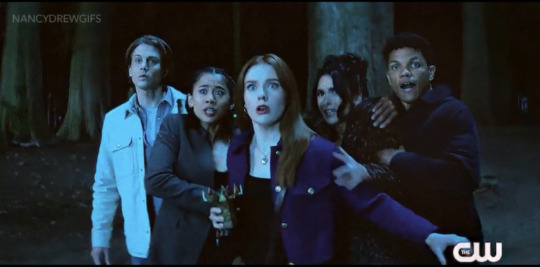
Much to discuss. From Ace and George’s wardrobe (and hair), this looks like Episode 5 - this is the episode featured in the official season announcement, directed by Scott Wolf, and with lots of cool scenes shared by Kennedy like this one and this one.


We have two other visual clues that make it more complicated. Bess is wearing her hair up like she wears with the sexy business dress w/name tag (as well as the official promo shot in the white blouse), and she’s got on the black and white coat from this blue screen scene.


And then Kennedy is wearing (I think) this super hot black dress under the blue denim jacket from the same timeframe. That last shot is from DP Nick Thomas - another woods scene that could be from Ep. 5 based on the timing (with stand-ins).


So Episode 5 (if all of this is Ep. 5) has a confrontation in the woods with a demon, a scene in the Claw with some kind of function that requires a name tag (a singles mixer? A pre-law/law school event?), Bess using magic, Nancy and George at a university, multiple scenes in the woods, and one in Icarus Hall with the Crew.
Many have also noticed that Ace is almost always on the outside of any grouping and sometimes apart from the others. Is this because he and Nancy have to stay apart due to the curse, or is it simply a visual framing device?
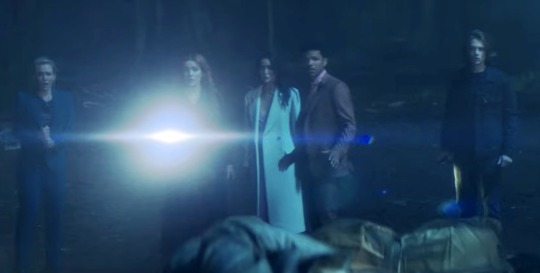
Speaking of Ace, the women are all dressed up while Ace is in another denim on denim look - is there an event where Nancy’s looking gorgeous but she doesn’t get to dance with Ace? GAH. We need a Nace slow dance in the worst way. Kennedy certainly hinted at Nancy’s agony at being at a party with Ace and not being able to interact with this tweet response to @sflcwers:

Now it’s possible the black dress is for the timey whimey prom Henry’s dressed for, and maybe the trailer’s demon scene is actually from episode 6 with some wardrobe holdover from 5, as they sometimes do.
My biggest question is - what the heck is Nancy holding in the trailer shot above? A magical MacGuffin that will help them fight the threat to the town? A weapon? A giant CHESS PIECE? It sort of looks like an oversized rook, and Kennedy previously gave us a chess EMOJI CLUE.

What if there’s some kind of chess-related mystery that relates to the sins of the past that they have to solve throughout the season? They have to find these chess pieces to save the town! Could it be something the Icarans planned from Icarus Hall? There’s quite a medieval fantasy theme going on with the crossbow, Nancy’s flower crown, and the Icarans sighting in Icarus Hall in the trailer.
OK, pure conjecture on my part, and the chess piece emoji could simply signify Game Night (which if so, yay!), but I LOVE a good mystical scavenger hunt a la the Horcruxes. I realize I may be going full on Beautiful Mind. Please give me your thoughts and theories in the comments/tags!
We still have those Icarans and spiders and proms and that NACE scene and Big Poppa Nancy to talk about, but these will have to wait for future posts as I’ve reached my photo limit here (sad). I’ll be back soon…
#nancy drew#nancy drew cw#ace [redacted]#nace#ndcw#nancy drew season 4#nancy drew s4#author: pluckysidekick
23 notes
·
View notes
Text
Did everyone know about this motherfucker or did I have to find out while googling stuff about Nelson
George Henry "Taters" Chatham (3 April 1912 – 5 June 1997) was a British thief and burglar. Born to a middle-class family, he aspired to become a professional footballer but despite a trial at Queen's Park Rangers, nothing came of it. Chatham turned to crime and was first convicted of theft in 1931. By the end of that decade he was burgling the houses of wealthy Londoners, carefully selecting his targets from society magazines. His calm-headedness led to his nickname from the Cockney rhyming slang for cold.
After the Second World War Chatham became more prolific. His crimes included the theft of two jewelled swords, awarded to the Duke of Wellington, from the Victoria & Albert Museum and a jewelled chelengk, awarded to Lord Nelson, from the National Maritime Museum. Chatham gambled away most of the proceeds from his crimes, often in the casino of London gangster Billy Hill. He was part of Hill's gang that carried out the 1952 Eastcastle Street robbery on a Post Office van. In 1957 he began a 30-year association with fellow thief Peter Scott.
Chatham's gambling led him to become increasingly reckless later in his career, though he was a famous cat burglar by the late 1950s and his raids on art galleries were attributed to a sophisticated international gang of art thieves. Chatham remained active late in life carrying out thefts and burglaries well into his 70s; his last crime was an attempted theft from an art gallery at the age of 81.
I hate people stealing historical artifacts, but this is also... wild
3 notes
·
View notes
Photo

MGM’s feature film Tarzan the Ape Man (1931), and its sequel, Tarzan and His Mate (1934), both starring former Olympic swimmer Johnny Weissmuller, turned out to be huge successes for the studio. They also cemented in the public’s mind the image of the monosyllabic, grunting ape man.
That iteration of the ape man was so popular that it was used in the non-MGM film serial Tarzan the Fearless (1933), starring another Olympic swimmer, Buster Crabbe.
Tarzan creator Edgar Rice Burroughs praised the films in public (they were making him money, after all), but privately hated their portrayal of his most prized creation. So he partnered with a family friend, Ashton Dearholt, and produced the 12 chapter-serial The New Adventures of Tarzan (1935).

The serial starred yet another Olympian, Henry Brix, in the title role. Ironically, Brix had been MGM’s first choice to play Tarzan in their films. Brix, unfortunately, broke his shoulder while filming another movie. MGM went with their second choice, Weissmuller, and the rest is history.
Frankly, just by physique alone I think Brix is the superior Tarzan. Even in his early films Weissmuller always looked a little doughy to me.
Brix’s Tarzan was also extremely faithful to the character from Burroughs’ novels: the cultured, educated, literate Lord Greystroke who spoke several languages, yet was unmistakably a man of action. This was the last time Tarzan would be depicted so until 1959′s Tarzan’s Greatest Adventure.

Once the troubled production was completed (and that story is practically a book in itself), movie theatres were offered two different was to exhibit the serial: as a stand-alone feature 70 minutes in length, entitled Tarzan and the Lost Tribe; or a feature-length (65 minutes) first episode, followed by the remaining 11 chapters.
Reviews of the film were generally poor in the US, and The New Adventures of Tarzan was the last Tarzan serial ever produced. However, like most Tarzan films of the time, it was a great success overseas. So much so, in fact, that in 1938 the last ten chapters of the serial were edited together to become the feature Tarzan and the Green Goddess.

Brix felt he was typecast after the serial was released, so he soon changed his name to Bruce Bennett. That’s how he’s billed in the numerous films and television episodes he appeared throughout the 1940s and 50s.
Some trivia regarding The New Adventures of Tarzan:
- The film was set, and largely filmed, in Guatemala.
- Producer Ashton Dearholt, who was married, met his leading lady, Ula Holt, on a previous trip to Guatemala. Dearholt was so smitten that he took Holt home to live with him. That promptly led Dearholt’s wife, Florence Gilbert, to leave with their two children and divorce him.
- Dearholt also played Raglan, the villain of the story. He claimed he had to step in to play the role when the actor hired for the part, Don Costello, got sick. This earns him the “George Santos Liar, Liar, Pants On Fire Award,” as there was no Don Costello. It was just a story Dearholt made up because he always planned to act in the film.
- Edgar Rice Burroughs fell in love with Dearholt’s ex, Florence Gilbert, when he first met her in 1929. During filming of the serial in 1935 Burroughs divorced his wife and married Gilbert, despite (or perhaps because) her being 30 years younger than him.
- Tarzan’s chimpanzee companion in the film was named Nkima, not Cheeta as in the MGM films. Jiggs the chimp played both roles, and he was paid $2,000 for his work in the serial.
- Herman Brix was hired at the salary of $75 a week but, other than his travel and accommodations in Guatemala, never got paid for his work.
- There are stories that Brix was personally chosen by Burroughs to play Tarzan. Brix himself stated that he only met Burroughs briefly after filming had wrapped. The only actor Burroughs actually picked for the role was Jim Pierce, for 1927′s Tarzan and the Golden Lion.
#The New Adventures of Tarzan#Tarzan#Herman Brix#Tarzan and the Green Goddess#Tarzan and the Lost Tribe#movie serials#Edgar Rice Burroughs
43 notes
·
View notes
Text
Dollar Bin #4:
Emmylou Harris's Angel Band

I visited four different Iowa record stores while dropping my second born off at college last week and I have much to report.
Yes, there are at least four record stores in the state. The mystery is how they stay open.
Emerson, Lake and Palmer records are deemed worthy of plastic protection in Iowa, and $25 Yes records come with handwritten stickers that say things like "Side 1 Skips!" followed by a frownie face. These stores are convinced - convinced! - that newly printed Guns and Roses records deserve places of high honor up on the wall and that Jerry Jeff Walker belongs in folk rock. After all, the Country section is behind a wall of dangling beads and George Jones fills an entire crate.
A rotund, nose-ringed salesdude nods when you enter, drops the store's diamond needle on Bad to the Bone, then ambles over to offer you a tour "of their whole set up" while bragging about the minty, clear vinyl, limited edition Blink 52 record they just scored for $75 even though it's worth $300, easy.
I was happy for the dude, I really was, but I shook them off, strode past a pickle barrel of still cellophaned tapes (4 for $5!) and found that their Neil Young section was - I swear to god - entirely empty.
Is that even legal? I mean can you really own a record store and not have a single Neil Young record? And how, you ask, are such stores even in business?
I'll tell you how: at one of them I found, after 30 years of earnest hunting, my first ever copy of Henry the Human Fly (it was an original Reprise print no less, and even though I could really give a flying turd about such things - this is the Dollar Bin after all, not Nathan's VGG++ Nerd World - I was still pretty damn fired up and almost hugged the salesdude). Anyway, I snapped up that little blue number for the very non-Dollar Bin price of 37 bucks, thereby keeping that store in business long enough for them to blast George Thorogood for another glorious day. B-B-B-B-Bad!
All kidding aside, the people of Iowa are amazing. At stop signs drivers wave to one another! Please pack up all spare copies of your favorite records, drive to Iowa, and donate them to those lovely people.
I don't know about you, but every time I enter a new record store for the first time I head straight to Young, Neil and start judging the place. I don't really expect to find anything by Neil that I don't already have - but please, God, please help me find a copy of Ragged Glory someday, and please make it cost less than $50; I don't ask for too much God but this one favor I do of you most humbly implore - but Neil's section is an easy and effective way to find out if the store is worth my time. Or yours.
If there's nothing to be found other than a $22 copy of Comes a Time, or even worse, nothing but an already dusty, year-old copy of Noise and Flowers for $65, I know I'm better off at Chili's eating a bloomin onion alone; if they have nothing but copy after copy of Re-ac-tor, Time Fades Away and Journey Through the Past, I stay open minded - maybe ten minutes earlier they sold a crunchy old copy of On The Beach; and if they have Old Ways or Trans for $8-10 it's time to get excited and explore the store.
Stop #2 for me in any new record store is always Emmylou Harris. I submit for your consideration the following thesis: a good record store should have on stock most, if not all, of her records between Gliding Bird (1970) and Bluebird (89). We're talking about something like 15 titles between those bookends, and all of them should be in any good record store for under 8 bucks a piece.
Don't get me wrong: these records should not be cheap given their quality. I am hear to tell you that Emmylou Harris does not make bad, or even mediocre records. Like Paul Simon (well, there is Songs from The Capeman...), she only releases good albums. The same cannot be said for Neil or Bob, though I love them dearly. I defy even my famous brother to find an argument for Down in the Groove or The Monsanto Years.
(For those at home taking notes: I did indeed make the statement in an earlier post that Neil can do no wrong. I stand by that statement! Dylan and Young alike put out crap intentionally. It's what genius's do, people! Come to think of it, that's why some (maybe all!) of my posts are gonna suck. Neil, Bob and I are simply shaking off any fair weather fans.)
But back to Emmylou: why, you ask, should every record store worth its salt have all her records cheaply in stock?
Consider:
A) between 75 and 89 she put out a record a year, all of them good, and sold them consistently to my mother and all my mother's friends and all my mother's friends' friends and... you get the idea: that's a lot of records;
B) all those women have, since they made those purchases, got a life. Unlike me. They don't need their records anymore and they've told their loser sons to put down their bongs and go out and do something with all their old vinyl in the hopes that the sons will learn entrepreneurship and decency in the process. Those loser sons have, in turn, not ignored their mother and listened to the Emmylou Harris records (like they should have!) but instead taken them to their local Treasured Vinyl and exchanged them for autographed copies of Roll the Bones, or some other comparable crap;
C) unlike her friend Dolly Parton, Emmylou has no amusement park to call home, nor any lifetime movies made in her honor; and, finally,
D) unlike Fleetwood Mac, no boyband applicant on a skateboard drinking juice has destroyed the internet with one of her songs as a soundtrack, thereby unleashing hoards of hipster kids to demand of all the local rotund record store dudes copies of Rumors.
Put all that together friends, apply a little supply and demand, and what do you get? Record stores should be full of cheap and outstanding Emmylou Harris records.
So let's focus in on one of my favorites and one that I bet none of you have ever listen to, Angel Band.
There's no getting around it, I have to tell you: Angel Band is a Jesus record.
Don't panic! You haven't been lured in here to be told that He Gets You. Instead, it's time for this entry's second thesis: Angel Band is The Best Jesus Record (by a white person, anyway).
That's right, it's better than Saved, Jesus Was a Capricorn, My Mother's Hymn Book and everything Van the 80's Jesus man ever put out. By far! Indeed, I'd even go so far as to argue that while listening to Angel Band you will forget altogether that the man from Galalee is even involved.
Before I preach the word of Emmylou, let's listen to the opening track.
youtube
I kinda feel like I could just end this entry right here. What can anyone possibly say other than Jesus Christ! The barely there but perfect band creates simple and delicious space around Harris' aching goddess of a voice. If some jerk doctor ever tells me I need to stop drinking beer (dear God, I'm back! Never mind my earnest appeal for Ragged Glory. Rather, God, please avert that hateful beerless future!), then I'm gonna have to listen to this album every day just to calm the hell down.
My prime hobby in life (good news everyone: as of this morning this blog is my day job because, thanks to my famous brother, I now have like 16 followers and surely that means cash money is coming my way, yes? Isn't that how the world wide web works? Siri, where's my paycheck?!) is teaching High School English and History; in that role I teach a four week block each year on The Holy Books.
The class is easy to teach even though I'm not a regular church goer; tell cool teens about Muhammad getting seized by the Angel Gabriel, back that up by showing them that Abraham is everyone's mythical great-grandad and they are all in. But, given the fact that Donald Trump and Samuel Alito continue to exist and threaten all our lives, Jesus is a tough sell to teens. (See that? Right there I'm not shaking off any new fair weather fans; I'm telling any Trump people reading this to go away and stop acting like shitheads.)
I do what I can in my Holy Books course to salvage Christianity: we get to the good stuff within the Sermon on Mount and St. John's Prelude and we separate St. Augustine's hateful nonsense from the essence of Christ. But the turning point, the moment when smart, open-minded kids realize that Jesus is about love without exception, not hate, often comes not through the texts or through my earnest lectures, but instead when I play them them The Stanley Brothers Angel Band or The Louvin Brothers I See A Bridge. No spiritual teaching that leads to such beauty could be altogether with merit, and kids get that.
youtube
Just about any song on Angel Band could win that same argument, including Harris' version of the title track. Covering a song that is perfect to begin with is either a brilliant move (see Dark End of the Street, originally by James Carr, and the versions by Linda Ronstadt and Richard and Linda Thompson), shrugable (Neil Young singing If You Could Read My Mind) or intolerable and gross (Stephen Stills' version of The Loner - I curse thee Stephen Stills!). But as far as I'm concerned Emmylou Harris could cover anything, from Will to Love to Love Shack, and make it great.
So get over your fear of Jesus, dive into your local dollar bin and relax while listening to Angel Band. God, if we are lucky, exists. And she sings just like Emmylou Harris.
7 notes
·
View notes
Text
Who is the worst founding father?
Round 5: Thomas Jefferson vs Henry Clay

Thomas Jefferson (April 13, 1743 – July 4, 1826) was an American statesman, diplomat, lawyer, architect, philosopher, and Founding Father who served as the third president of the United States from 1801 to 1809. Jefferson was the primary author of the Declaration of Independence. Following the American Revolutionary War and prior to becoming the nation’s third president in 1801, Jefferson was the first United States secretary of state under George Washington and then the nation’s second vice president under John Adams.
Starting in 1803, he promoted a western expansionist policy with the Louisiana Purchase and began the process of Indian tribal removal from the newly acquired territory.
In confidential talks with French consul Joseph Létombe, Jefferson attacked President John Adams and predicted [he] would serve only one term, encouraged France to invade England, and advised Létombe to stall any American envoys sent to Paris by instructing him to “listen to them and then drag out the negotiations at length and mollify them by the urbanity of the proceedings." This toughened the tone that the French government adopted toward the Adams administration.
Jefferson lived in a planter economy largely dependent upon slavery, and used slave labor for his household, plantation, and workshops. Over his lifetime he owned about 600 slaves.
During his presidency, Jefferson allowed the diffusion of slavery into the Louisiana Territory hoping to prevent slave uprisings in Virginia and to prevent South Carolina secession. In 1804, in a compromise on the slavery issue, Jefferson and Congress banned domestic slave trafficking for one year into the Louisiana Territory.
In 1819, Jefferson strongly opposed a Missouri statehood application amendment that banned domestic slave importation and freed slaves at the age of 25 on grounds it would destroy the union.
Jefferson never freed most of his slaves, and he remained silent on the issue while he was president.
Since the 1790s, Jefferson was rumored to have had children by his sister-in-law and slave Sally Hemings, known as the Jefferson-Hemings controversy. According to scholarly consensus…as well as oral history, Jefferson probably fathered at least six children with Hemings.
---
Henry Clay Sr. (April 12, 1777 – June 29, 1852) was an American attorney and statesman who represented Kentucky in both the U.S. Senate and House of Representatives. He was the seventh House speaker as well as the ninth secretary of state. He unsuccessfully ran for president in the 1824, 1832, and 1844 elections. He helped found both the National Republican Party and the Whig Party. For his role in defusing sectional crises, he earned the appellation of the “Great Compromiser” and was part of the “Great Triumvirate” of Congressmen, alongside fellow Whig Daniel Webster and John C. Calhoun.
[Clay and his family] initially lived in Lexington, but in 1804 they began building a plantation outside of Lexington known as Ashland. The Ashland estate eventually encompassed over 500 acres (200 ha), with numerous outbuildings such as a smokehouse, a greenhouse, and several barns. Enslaved there were 122 during Clay’s lifetime with about 50 needed for farming and the household.
In early 1819, a dispute erupted over the proposed statehood of Missouri after New York Congressman James Tallmadge introduced a legislative amendment that would provide for the gradual emancipation of Missouri’s slaves. Though Clay had previously called for gradual emancipation in Kentucky, he sided with the Southerners in voting down Tallmadge’s amendment. Clay instead supported Senator Jesse B. Thomas’s compromise proposal in which Missouri would be admitted as a slave state, Maine would be admitted as a free state, and slavery would be forbidden in the territories north of 36° 30’ parallel. Clay helped assemble a coalition that passed the Missouri Compromise, as Thomas’s proposal became known. Further controversy ensued when Missouri’s constitution banned free blacks from entering the state, but Clay was able to engineer another compromise that allowed Missouri to join as a state in August 1821.
#semifinals!#founding fathers#worst founding father#founding father bracket#amrev#brackets#polls#thomas jefferson#henry clay
18 notes
·
View notes
Text
The Shadohunter Chronicles Character Showdown
First Round, Second Round, Third Round, Fourth Round, Fifth Round, Semi-Finals, Finals
Auraline vs Kit Herondale, (Apr 28)
Max Lightwood vs Jessamine Lovelace, (Apr 29)
Isabelle Lightwood vs Gabriel Lightwood, (Apr 30)
Tessa Gray vs James Herondale, (May 1)
Raphael Santiago vs Irene, (May 2)
Julie Beauvale vs Robert Lightwood, (May 3)
Will Herondale vs Alastair Carstairs, (May 4)
Cecily Herondale vs Cristina Mendoza-Rosales, (May 5)
Henry Branwel vs Ty Blackthorn, (May 6)
Stephen Herondale vs Elyaas the Demon, (May 7)
Sona Carstairs vs Rosemary Herondale, (May 8)
Hypatia Vex vs Thais Pedroso, (May 9)
Anush Joshi vs Max Lightwood-Bane, (May 10)
Alexander Lightwood vs Simon Lovelace-Lewis, (May 11)
Dru Blackthorn vs Rafeal Lightwood-Bane, (May 12)
Cordelia Carstairs vs Helen Blackthorn, (May 13)
Jace Lightwood-Herondale vs Eugenia Lightwood, (May 14)
Grace Blackthorn vs Diego Rocío-Rosales, (May 15)
Charlotte Fairchild vs Chairman Meow, (May 16)
Rupert Blackthorn vs Matthew Fairchild, (May 17)
Cameron Ashdown vs Filomena di Angelo, (May 18)
Emma Carstairs vs Jia Penhallow, (May 19)
Beatriz Mendoza vs Kraig, (May 20)
Jordan Kyle vs Bridget Daly, (May 21)
Gideon Lightwood vs Alec Lightwood-Bane, (May 22)
Anna Lightwood vs Julian Blackthorn, (May 23)
Jem Carstairs vs Maryse Lightwood, (May 24)
George Lovelace vs Magnus Lightwood-Bane, (May 25)
Tavvy Blackthorn vs Barbra Lightwood, (May 26)
Aline Penhallow vs Sophie Collins, (May 27)
Clary Fairchild vs Christopher Lightwood, (May 28)
Zachary Carstairs vs Lily Chen, (May 29)
#shadowhunters#the shadowhunter chronicles#tsc#the dark artifices#tda#the mortal instruments#tmi#the last hours#tlh#the wicked powers#twp#tid#the infernal devices#shadowhunter character showdown 2024
13 notes
·
View notes
Note
Any info on Louise Sébastienne? I’d like to know more about her :3
You mean Danton’s second wife? In that case, good question, but unfortunately not one I think has very exciting answers… Louise left no written material behind, nor could I find any letters adressed to her. All that we really have are documents briefly mentioning her.
Louise was born in Paris on March 3 1776. Her parents were Marc-Antoine Gély (1751-18) and Marie-Jeanne Léger Revel (1759-1825). According to Claude-François-Étienne Dupin (1767-1828) De la Révolution à la restauration, au service des administrés (2015) by Gildas Dacre-Wright, Louise was the youngest of three daughters. At the time of her marriage with Danton, she lived with her parents on the second floor of 24 of Cour de Commerce, a floor above her future husband.
When going through Danton biographies in order to find any info on Louise, three claims regarding the nature of their union continuously showed up. The first was that Louise knew the Dantons before marrying Georges, some saying her father Marc-Antoine had gotten into contact with Danton’s father by frequenting the latter’s café (Danton (1914) by Louis Madelin, Danton (1935) by Hermann Wendel), others that she was Gabrielle’s friend (Danton (1978) by Normann Hampson, Danton (1987) by Frank Dwyer). The second claim was that it was Gabrielle who begged the two to marry as a last wish (Life of Danton (1906) by Augustus Henry Beesly, Danton (1978) by Normann Hampson, Danton (1987) by Frank Dwyer and the third that Louise, being a religious person, was the one who asked for the ceremony to be officiated by a refractory priest (Danton (1914) by Louis Madelin, Danton (1978) by Normann Hampson, Life of Danton (1906) by Augustus Henry Beesly, Danton (1935) by Hermann Wendel). However, none of these could cite a primary source (or any source for that matter) for these claims, Augustus Henry Beesly going so far as to say ”There is a story that his first wife had recommended the marriage” and Norman Hampson that ”Gabrielle is said to have urged Louise Gély, a friend of the family and barely fifteen, to take care of her two boys. Louise is believed to have insisted, not merely on a religious marriage but on one celebrated by a priest who had refused to accept the revolutionary religious settlement.” So perhaps these are just apocryphal claims that hold themselves alive because no one bothers to check their origin properly.
Regardless, the marriage contract was passed on June 14 1793, in the presence of family members of the bride and groom. According to it, Louise received a dowry of 10 000 livres from her parents, along with 30 000 livres from Danton’s aunt Lenoir, to have if she was to survive her husband.
According to Danton, Mémoire sur sa vie privée (1865) Louise and Danton had a child together that died young, although I’ve not seen that claim repeated anywhere else… EDIT: it could be from Histoire de la Révolution française (1850) by Nicolas Villiaumé, who in his turn claimed to have gotten the story from Louise herself:
[After the arrest of Danton and Desmoulins] Lucile ran to Madame Danton to suggest that she come with her to go find Robespierre, ask him for an explanation, and recall the feelings of friendship which had attached him to their husbands. Madame Danton refused, saying that she wanted nothing from a man who had showed himself to be the enemy of her husband. (I obtained this particularity from Madame Danton herself, who was then pregnant. She gave birth fifteen days after Danton's death, but her child did not live.)
On July 10 1794 a register was signed, handing custody of Danton’s two surviving children over to their maternal grandfather. Louise did not sign this paper, but her father did (perhaps only men could do it?). It’s hard to tell if Louise had taken care of her step-sons up until that point (that’s the conclusion drawn in Life in Revolutionary France (2020) by Mette Harder) or if they were taken in by their grandparents immediately and this was just a formal thing. It would nevertheless appear like Louise kept up contacts with Danton’s family. The paper L’Éclair wrote in 1895 that ”a correspondence (which I’ve not found any trace of) attests that Danton’s second wife and her father were still in contact with Danton’s sons and sister-in-law during the second empire.” Louise’s second husband, Dupin, had known the family before they married, and the godfather of the couple’s first surviving child may have been Danton’s brother-in-law François Victor Charpentier. Similarily, in 1812, Charpentier’s wife Constance painted a portrait of Louise (”Baronne Dupin”). Danton’s sons, however, couldn’t even get Louise’s name right in a memoir written 1846:
In the course of this same year, 1793, we cannot indicate the precise time, he (Danton) married, as his second wife, mademoiselle Sophie (sic) Gély, who was still alive two years ago (we do not know if she has died since).
On July 13 1795, Louise was present for the removal of seals for Danton’s old house, playing the role of Danton’s attorney general. According to the protocol she had at this point moved to Arcis-sur-Aube, where Danton’s mother also lived.
Louise got remarried to Claude-François-Étienne Dupin, by then chief secretary of the department of Seine, in 1796. They had a religious wedding ceremony on May 9 and a civil one the day right after. According to Claude-François-Étienne Dupin… (2015) the ceremony was presided over by abbé de Keravenant, who had also been in charge of the one between Louise and Danton. Louise’s father, along with four others, were the only witnessses. Louis Madelin claimed in his Danton (1914) to have received letters from people who knew Louise as an old woman, telling him that she disliked talking about Danton after remarrying.
The couple first settled down in Danton’s old apartment, but they would move around a lot in the years to come, starting two years later when they went to live at Rue du Théâtre français instead. Dupin, being appointed baron of the Empire in 1809, sometimes went on long missions, while Louise mostly stayed at home and gave birth to their children. In 1808 the family moved to Niort after Dupin was appointed there, whose Maternal Charity Society (whose goal it was ”to help poor women in childbirth, to provide for their needs and help with the breastfeeding of their children”) Louise became a member of in 1812. They moved back to Paris one year after that. Dupin died 1828 and Louise 28 years later, aged 80. Both were buried in the Montparnasse Cemetery.
Dupin and Louise had five children together, of which the two youngest lived to see adulthood, a girl, Camille Antoinette (born 1801) and a boy, Antoine Louis Gabriel (1804-1856). The latter married in 1832 and had a child fifteen years later, but after that his lineage seems to end. Camille on the other hand had a girl, Marie Bellot de Kergorre (1837-1884), who in her turn gave birth to the French author René de Laigue (1862-1942, who actually has his own wikipedia page). René had two daughters that died in 2002 and 2008 respectively. I can’t find any info on whether they had children or not, but if they did, it’s possible Louise still has descendants that are alive and kicking, and if not, she at least had not that long ago.
Since, as mentioned, Louise left no writings behind, I couldn’t find anything regarding the idea that she was a royalist, which is what’s claimed on wikipedia among other places.
24 notes
·
View notes